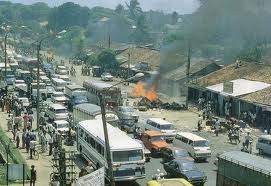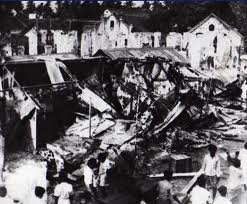In July 1983 it is claimed that a spontaneous violence of the Sinhalese population spurred against the Tamils. It wasn’t the first time. Most notably in 1958, but during the ’60s and ’70s, tension was registered amongst the two ethnic group. Or better: anger and violence from the Sinhalese majority towards the Tamil minority. In fact the killing of the Four Four Bravo patrol was the first example of organized, Tamil aggression. Critically, against a military target.
So, from independence in 1948 to 1983, you have 30 years of growing animosity towards the Tamil minority, which is less and less tolerated. And precisely for that, the Tamil population tried to maintain a very low profile. Indeed the request was simply to exist as a distinctive community, with its own language and cultural identity, within the Sri Lankan state.
This is crucial: the Tamils demanded only to exist as Tamils. And they conducted a very peaceful and non violent struggle. And the constant denial of the Sri Lankan state produced a very logical and obvious outcome: if the Sinhalese can’t tolerate the Tamil presence within the same state, it will be better to have a separate one. The request of an independent, separate state indeed came to prominence only in the ’70s, when it was clear that the state couldn’t or didn’t want to protect the Tamil citizens.
 This is a point. The official position of the Sri Lankan state has been of mediator between the violent request of the Sinhalese majority and the peaceful resistance of the Tamil minority. It seems as the Sri Lankan government identity is shaped by the containment of Sinhalese justified violence against the Tamils. And sometimes you have to let steam off. It is only but natural that once in a while the majority will overcome its barely repressed tolerance and slash the obnoxious presence of the minority. This is more or less the message. That the Tamil presence is unnatural and it is not completed eliminated only because of mercy by the majority. But you can really blame it if reacts when provoked.
This is a point. The official position of the Sri Lankan state has been of mediator between the violent request of the Sinhalese majority and the peaceful resistance of the Tamil minority. It seems as the Sri Lankan government identity is shaped by the containment of Sinhalese justified violence against the Tamils. And sometimes you have to let steam off. It is only but natural that once in a while the majority will overcome its barely repressed tolerance and slash the obnoxious presence of the minority. This is more or less the message. That the Tamil presence is unnatural and it is not completed eliminated only because of mercy by the majority. But you can really blame it if reacts when provoked.
And when a military action took place like in 1983, the reaction involved all the Tamil community. And that was one example where the government couldn’t really defend the minority.
 But this impotence was an act of will. In fact the pogroms done by the so-called ‘mob’, were actually quite organized and planned. Properties were carefully targeted, people picked up, check point set up and weapons made available. Most important, the police and the army didn’t really intervene and crack down this form of violence. The state has the right and the duty to eliminate any challenge to its sovereignty. The LTTE attack is an example and the ‘spontaneous mob violence’ is another one. But in the latter, nothing happened. The government actually accepted that kind of violence. You have two possible reasons: the mob violence is actually just an extension of the state will. The government is acting through the thugs, beyond its own legal framework.
But this impotence was an act of will. In fact the pogroms done by the so-called ‘mob’, were actually quite organized and planned. Properties were carefully targeted, people picked up, check point set up and weapons made available. Most important, the police and the army didn’t really intervene and crack down this form of violence. The state has the right and the duty to eliminate any challenge to its sovereignty. The LTTE attack is an example and the ‘spontaneous mob violence’ is another one. But in the latter, nothing happened. The government actually accepted that kind of violence. You have two possible reasons: the mob violence is actually just an extension of the state will. The government is acting through the thugs, beyond its own legal framework.
Or the government can’t really act against the force that intimately legitimized its authority: the assumption that the Sri Lankan state is founded on the Sinhalese affirmation, which is more grounded that the rule of law. And when the Sinhalese affirmation take a violent form, it is granted legitimacy by its own force. This is a tribal law, whose constitution is illiterate and drawn with blood.
In either cases if you are Tamil, your chances of survival are quite low. Because your state made a point of erasing your identity. Assimilation or elimination. Sri Lanka is not a country for Tamils. Cornered in such a way, some in the Tamil community felt that they had little to lose in fighting till death the Sri Lankan state.






